Last Updated February 2018.
Modelling Primate Intelligence and Social Behaviour
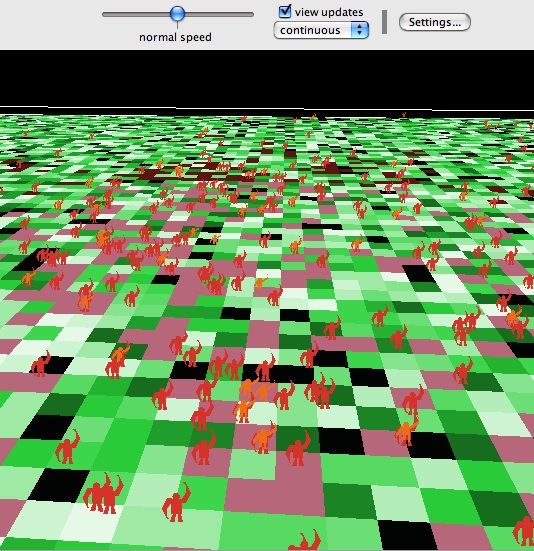
Skip to:
Software for simulations in the below research is available from the AmonI
software page.
Background & Funding
Learning and intelligence in humans and other primates is
interesting from both a scientific and an engineering perspective,
because we primates learn more than other classes of
animals. Our understanding of natural
intelligence is enhanced when we build models of it, because
we can test whether our theories really generate the behaviour we
predict, and whether that matches what we see in nature. If
we don't understand the biological origins of cognition, then we
can't really understand what computation is for, how it
benefits an individual or a population. Without understanding
this, we can't say what AI should look like, nor what the
appropriate role is of AI in society.
Not all of the papers here are basd on humans. Non-human
primates are a little easier to model than humans because:
- We have more complete data about how they spend their
time. Non-human primates don't seem to mind being observed
every minute of the day (provided the observers are familiar and
well-behaved) so we can get the kind of complete, quantitative
statistical data on their social interactions that is impossible
to get from humans.
- Non-human primates acquire significantly less behaviour
culturally, partly because they don't have language. That
means their behaviour changes more slowly, so it is easier to
keep up with long enough to model.
The work on this page ranges from basic primate cognition and
task learning, through general social behaviour, and itno the
specifics of human culture and its origins. My group takes a
computational perspective on both cognition and culture: culture
can be thought of as cognition / computation distributed across a
population.
This research program began during my 2001 PhD
dissertation work on Systems AI.
Since 2002 I have been working with colleagues in AmonI studying
the interaction between individual learning and thinking, and the
intelligence provided by either evolution (in nature) or a
developer (in AI.) Note that in nature "provided"
intelligence can come from genetics or memetics – it can come
either via biology or from culture. AI too increasingly
mines our biology and culture for intelligence, but it has the
advantage of human programmers as well.
Funding
General and Specialized Learning of Tasks
Q & A on this research.
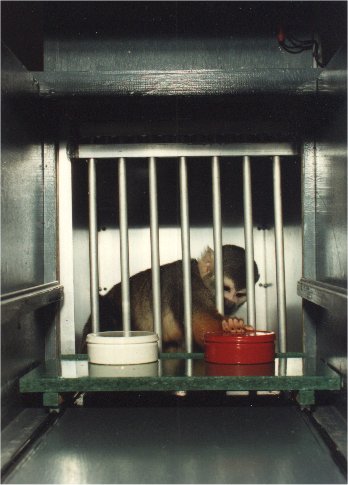 |
 |
These are pictures of a monkey working in a test
apparatus on transitive inference (TI), the first task
learning we've modelled. Pictures and original data come
from Brendan
McGonigle, collected at his lab in Edinburgh in the 1970s.
The subject is a Squirrel Monkey, Saimiri sciureus.
TI is a much-researched task and serves well as a
benchmark for theories of skill-learning. Originally
it was thought only humans can do it, but now we know even
rats and pigeons can, although they seem to do it
differently from primates. Like most learning tasks,
the best way to tell which theory is right is to look at how
well they account for the mistakes the subjects make.
This research led me to build a two-tier model of TI
learning. |
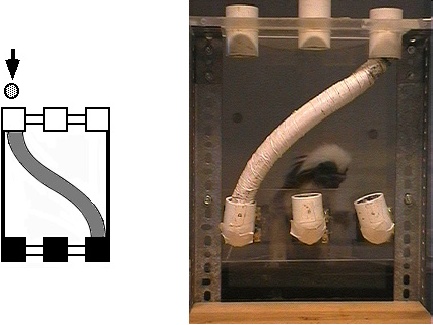 |
A monkey working on a puzzle at the Primate
Cognitive Neuroscience Laboratory at Harvard. This
participant is a Cotton-Top Tamarin, Saguinus oedipus.
The tamarin is trying to figure out Bruce
Hood's tube task, another puzzle originally given to
children. Despite the fact the food reliably goes down
the tube, monkeys and small children keep expecting it will
fall straight down. On the other hand, monkeys
can learn this task if the apparatus is placed horizontally.
This has led to the theory that their mistakes are a
`gravity fallacy.' Papers about the monkey data are here,
look for "gravity" in the title. Explaining this data
has led to extending and generalising the two-tier model.
|
Note: None of the animals in the above pictures live in their test
apparatus! Monkeys only participate in behavioural tests like
these if they enjoy it --- otherwise they refuse to work and there
is nothing that can make them pay attention. This does
occasionally happen, for example if there has been a big political
disruption the previous day in the monkey colony (two monkeys fought
or befriended each other) in which case they temporarily lose
interest in anything else. If you are worried about the ethics
of primate research, you might want to read
Why Primate Models Matter.
At least part of the reason the monkeys enjoy going to testing rooms
is because they know it is a good place to get treats (peanuts for
the squirrel monkeys, bits of Fruit Loops for the tamarins.)
But many monkeys seem to think puzzles are intrinsically interesting
and will play with them for a while at least even for no reward.
Related publications:
- Joanna J. Bryson and Marc D. Hauser, ``What
Monkeys
See and Don't Do: Agent Models of Safe Learning in Primates'',
Proceedings of the AAAI Symposium on Safe Learning Agents,
M. Barley and H. W. Guesgen, eds., AAAI Press March 2002.
- Mark Wood, Jonathan C. S. Leong and Joanna J. Bryson, ``ACT-R
is almost a Model of
Primate Task Learning: Experiments in Modelling
Transitive Inference'', in Proceedings of the 26th
Annual Meeting of the Cognitive Science Society (CogSci 2004),
pp. 1470-1475.
- Joanna J. Bryson and Jonathan C. S. Leong ``Primate errors in
transitive `inference': A two-tier learning model'' Animal
Cognition, 10(1), 2007. Associated
software.
- Joanna J. Bryson, Age-Related
Inhibition and Learning Effects: Evidence from Transitive
Performance, to appear at Cognitive
Science 2009 in July. Same software as above.
- Modelling
Natural Action Selection (Seth, Prescott & Bryson
eds.) on Cambridge
University Press, 2012.
Evolving Social Behaviours
 |
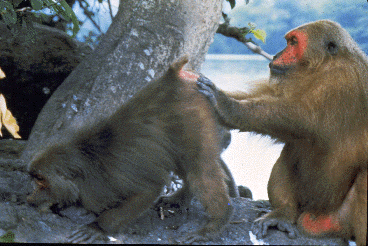 |
These are pictures (which I got from the
Internet) of two different species of macaque
monkeys in social interactions. Different species of
macaques, despite being closely related, have different
sorts of social structures. Some, such as the rhesus
on the left, have very strict social structures and violent
but infrequent fights. Others, such as the stumptails
on the right, have more egalitarian social structures with
frequent scuffles but few very violent incidents.
The original goal of our research was to examine two
conflicting theories of why this might be. Charlotte
Hemelrijk believes it is because the more structured
species evolved in more difficult climates with scarcer
resources, leading to more violent conflicts. More
violent conflicts in turn led to more structured
societies. Frans
de
Waal believes that more egalitarian species have
learned or evolved more social behaviours that help reduce
the seriousness of conflict. Thus, violence is a
consequence of species-wide behavioural ignorance. Carel
van
Schaik, among others, thinks that different social
structures are responses to different environmental
opportunities and threats --- this is called the
socio-ecological theory. Others like Bernard
Thierry think the differences are the result of chance
events over their phylogenetic history.
Charlotte Hemelrijk already has a well-published AI model
she used to try to demonstrate her model could be
plausible. However, we've replicated Hemelrijk's DomWorld model
(click there for more details including our code), and found
it was less applicable than she has said. Hagen Lehmann did most of this
work for his PhD, and has also built a model of the
socio-ecological model, which we are testing.
|
Related publications:
- Joanna J. Bryson, ``Where
Should Complexity Go? Cooperation in Complex Agents with
Minimal Communication'', Innovative Concepts for
Agent-Based Systems, W. Truszkowski, C. Rouff and M.
Hinchey, eds., pp. 298-313, Springer, 2003.
- Joanna J. Bryson and Jessica C. Flack, ``Action Selection for an
Artificial-Life Model of Social Behavior in Non-Human Primates'',
Proceedings of the International Workshop on
Self-Organization and Evolution of Social Behaviour, C.
Hemelrijk ed., pp. 42-45 , 2002.
- Emmanuel Tanguy, Philip Willis and Joanna J. Bryson, ``Emotions
as
Durative Dynamic State for Action Selection'', in The
Twentieth International Joint Conference on Artificial
Intelligence (IJCAI), Hyderabad, India, pp.1537-1542,
January 2007. Associated
software.
- Mark A. Wood and Joanna J. Bryson, ``Skill Acquisition through
Program-Level Imitation in a Real-Time Domain'', IEEE
Transactions on Systems, Man and Cybernetics Part
B--Cybernetics, 37(2):272-285, April 2007.
- Joanna J. Bryson, Yasushi Ando and Hagen Lehmann ``Agent-based models as
scientific methodology: A case study analysing primate social
behaviour'', Philosophical Transactions of the Royal
Society, B - Biology,
362(1485):1685-1698, September 2007. The case
analysed in this paper concerns Hemelrijk's
DomWorld, that link includes the associated software.
- Philipp Rohlfshagen
and Joanna J. Bryson, Flexible
Latching:
A
Biologically-Inspired
Mechanism
for Improving the Management of Homeostatic Goals in Cognitive
Computation 2(3):230-241 2010. Associated
software comes with the standard
python/jython distribution of BOD.
- Gideon M. Gluckmann & Joanna J. Bryson, An
Agent-Based Model of the Effects of a Primate Social Structure
on the Speed of Natural Selection, in Evolutionary
Computation and Multi-Agent Systems and Simulation (ECoMASS)
at GECCO 2011 in Dublin.
- Paul Rauwolf & I, Expectations
of Fairness and Trust Co-Evolve in Environments of Partial
Information, in press since 2017 with Dynamic Games
and Applications.
- This work has largely merged with my work below on culture and
language, because it became clear that dominance was related to
the social organisation underlying public goods creation,
including language. See further my web page on cultural
variation in human cooperative behaviour.
Evolving Human-Like
Culture
 |
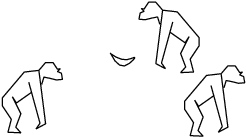 |
Individuals of most social
species (even guppies) keep track of how their group-mates
have treated them in the past.
|
Primates appear to also keep
track of how their troop-mates treat each other. This
takes much more memory, and possibly compositional
reasoning.
|
Scientists, philosophers, and of course many ordinary people have
long wondered about what makes us special --- well, really what
makes me special (where me is each of us), but from
that, my planet, my country, my species.
Although we probably share more of our intelligence and motivation
with related species than we realise, there is no question that
contemporary human lives are really quite different from the lives
of other animals. We are the only ones with such elaborate and
varied artifacts like buildings and laptop projectors, and we are
the only ones who transmit behaviour via language. We are also
different from other species in a large number of other ways.
But the question is, which difference(s) came first? Science
favours parsimonious answers, so we are looking for just one or a
few simple differences between us and other species that might
explain all the other differences.
I became professionally involved in these questions through
attending the Evolution of Language conferences. Originally I did
this just because it was such an interesting and interdisciplinary
group of scientists, not because I was interested in language
origins. But I came to realise that understanding the social
transmission of behaviour was fundamental to understanding
intelligence. Consequently my hobby changed into the main
topic of my two-year research sabbatical in 2007-2009.
Here are my current understandings of the issue. For references and
evidence, see the papers below:
- The altruistic communication of behaviour is easy to evolve.
- Species are cultural (that is, they communicate behaviour by
means other than reproduction) broadly to the extent that they
are cognitive. That is, if they learn and think at all,
they are very likely to exploit the learning and thinking of
their conspecifics.
- The reason many species have neither culture nor cognition is
because learning is slow, unreliable and costly. The
reason some species do have it is because individual plasticity
can accelerate biological evolution, thus producing adaptive
tradeoffs. Adaptive tradeoffs in turn produce species-level
variation.
- In humans, cultural evolution happens faster so we use it
more. This is because language allows both faster
transmission of ideas and cognitive compression of concepts into
simpler and more manipulable representations.
- We evolved language in the first place because we happened to
be the only species to combine two or a few useful traits:
- The ability of perfect, temporally precise imitation.
This probably evolved due to sexual selection for vocal
imitation, as it has in other species. This gives us a
representational substrate rich enough in information to
provide robust, redundant cues to meaning, thus allowing an
unsupervised learning process like evolution to operate.
I'm sure this was essential.
- The ability for compositional reasoning. This ability
co-evolved with our complex social structure, and we share it
with other higher primates. However, no other higher
primates happen to be able to do vocal imitation. The
compositional capacity in humans allows the compositional
(recursive) structure of language, which gives it much of its
power to overcome combinatorial
complexity. I've written a few papers about this,
but I am also entertaining a simpler hypothesis right now...
- The ability to remember a lot of stuff. Apes have
long lives and big heads, presumably in order to keep track of
their social affiliations and their vast and creative set of
feeding strategies. We and our ancestors may be the only
vocal imitators with enough individual "work space" for
cultural evolution to have generated such an efficient
representation as language.
Related publications:
- Ivana Cace and Joanna J. Bryson, ``Agent
Based Modelling of Communication Costs: Why Information Can Be
Free.'', in Emergence and Evolution of Linguistic
Communication C. Lyon, C. L Nehaniv and A. Cangelosi,
eds., pp. 305-322, Springer 2007.
- Steven Butler and Joanna J. Bryson ``Effects
of Mass Media and Opinion Exchange on Extremist Group
Formation'', in The Proceedings of the Fourth
Conference of the European Social Simulation Society (ESSA
'07), Toulouse, France, pp. 455-465 2007. Associated
software.
- Joanna J. Bryson ``Embodiment
vs. Memetics'', Mind
& Society, 7(1):77-94, June 2008.
- Avri Bilovich and Joanna J. Bryson, Detecting the Evolution
of Semantics and Individual Beliefs Through Statistical
Analysis of Language Use, Proceedings of the Fall AAAI
Symposium on Naturally-Inspired
Artificial
Intelligence, Washington DC, November 2008. Associated
software.
- Joanna J. Bryson ``Representations
Underlying Social Learning and Cultural Evolution'', Interaction
Studies, 10(1):77-100,
March 2009.
- Joanna J. Bryson, ``Cultural
Ratcheting Results Primarily from Semantic Compression''.
The Proceedings of Evolution
of Language 2010, Smith, Schouwstra, de Boer & Smith
(eds.) pp. 50-57.
- Harvey
Whitehouse, Ken
Kahn, Michael E.
Hochberg, and Joanna J. Bryson, The
role for simulations in theory construction for the social
sciences: Case studies concerning Divergent Modes of
Religiosity, Religion,
Brain & Behaviour, 2(3):182-224 (including
commentaries and response.) Associated software is in the
electronic appendix and on the AmonI
software page. Bath hosts open access versions of the target article and the response, for the
full PDF (including commentaries) email me.
- Simon T.
Powers, Daniel
J. Taylor and Joanna J. Bryson, Punishment
can promote defection in group-structured populations,
in The
Journal of Theoretical Biology, 311:107-116.
Archived preprint.
More on Costly
Punishment.
- Joanna J. Bryson, The Role of
Stability in Cultural Evolution: Innovation and Conformity in
Implicit Knowledge Discovery, book chapter in Perspectives
on Culture and Agent-Based Simulations, Virginia and Frank
Dignum, (eds), Springer, Berlin 2013. Associated
software.
- Joanna J. Bryson, James Mitchell, Simon T. Powers, and
Karolina Sylwester, Understanding and
Addressing Cultural Variation in Costly Antisocial Punishment.
To appear in Applied
Evolutionary Anthropology, Gibson & Lawson (eds.),
Springer. Revised version from May 2013. More
on Costly Punishment.
- Eugene Y. Bann and Joanna J. Bryson, Measuring Cultural
Relativity of Emotional Valence and Arousal using Semantic
Clustering and Twitter, Proceedings
of Cognitive
Science 2013, pp. 1809-1815.
- Paul Rauwolf, Dominic
Mitchell, and Joanna J. Bryson,
Value homophily benefits cooperation but motivates employing
incorrect social information, Journal of Theoretical
Biology 367:246–261.
- Dominic Mitchell, Joanna J. Bryson, Paul Rauwolf, and Gordon Ingram,
On
the reliability of unreliable information: Gossip as cultural
memory, in Interaction
Studies, vol. 17:1
pp. 1–25.
- I have two short book sections in the collection Memory
in the Twenty-First Century, edited by Sebastian Groes,
published by Palgrave Macmillan: Simulation
and the Evolution of Thought (open
access version), from Part IV Memory
and the Future (pdf), and The
Confabulation of Self (open
access version), from Part VI, Twenty-First
Century Subjectivities (pdf.)
- Aylin
Caliskan, Joanna J. Bryson, & Arvind Narayanan, Semantics
derived automatically from language corpora contain human
biases. Science 356 (6334):183-186 [14 Apr
2017]. Be sure to also look at the
supplement, which gives the stimuli and shows similar
results for a different corpus and word-embedding
model. Meaning really is no more or less than how a
word is used, so AI absorbs true meaning, including
prejudice. We demonstrate this empirically. Open
access version: authors'
final copy of both the main article and the supplement.
Note that the above work has recently started influencing my AI
ethics work, notably Artificial
Intelligence
and Pro-Social Behaviour from the October 2015 Springer
volume, Collective
Agency and Cooperation in Natural and Artificial Systems:
Explanation, Implementation and Simulation, and Joanna J.
Bryson, Patiency
Is Not a Virtue: The Design of Intelligent Systems and Systems of
Ethics, in press (on line first) with Ethics and Information
Technology in 2018
Software for simulations in the above articles is available from the AmonI
software page.
page author: Joanna Bryson
Back to AmonI
Research
Back to Understanding Natural Intelligence









